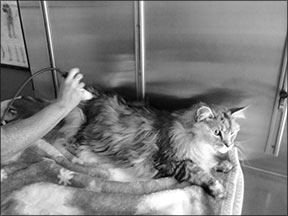Don’t be surprised if your cat’s veterinarian dons special dark goggles in the exam room and applies a handheld wand to targeted areas on your cat’s body to speed up healing from surgery or ease the pain of arthritis. The latest tool in pain management — called cold laser therapy — is quickly gaining acceptance from veterinarians in teaching hospitals and small animal practices across the country.


288
The medical treatment, also called low-level laser therapy, was first introduced in human medicine nearly 50 years ago. It has been used in animals for about 10 years, but only in the past few years has its popularity grown.
Anecdotal Reports. While the effectiveness of this mode of therapy has not been fully evaluated by controlled studies in veterinary patients, its benefits may be considerable judging by the anecdotal reports.
Today, veterinarians are using low-level lasers to treat a variety of conditions, including asthma, renal and thyroid diseases, arthritis and other join pain, open wounds that are slow to heal, inflammatory bowel disease and feline eosinophilic granuloma, a complex skin condition that causes rashes, bumps, ulcers and swelling on the thighs, face, mouth and abdomen.
Low-level lasers represent a cutting-edge therapy that is turning many doubters into advocates. Among them is anesthesiologist Andrea Looney, DVM, Senior Lecturer in the Section of Pain Management at the Cornell University College of Veterinary Medicine. She emphasizes that cold lasers are not the same as surgical lasers. “Cold lasers don’t coagulate or cut tissue, but they are able to positively affect all kinds of healing processes,” she says. “Any tissue with pain or inflammation can be affected.”
Non-invasive Treatment. In her work, Dr. Looney encountered cats who wouldn’t accept acupuncture needles for post-surgery therapy and decided to try cold lasers. Because cats can move fast and often feel stressed at clinics, some of them don’t easily tolerate acupuncture, she says, adding that a noninvasive treatment like lasers seems to have a soothing effect on them.
“I started using cold laser therapy for these cats and the results were pretty miraculous,” says Dr. Looney. “We saw improvement in their mobility, even in senior-aged cats.”
Cold lasers use short wavelength light to generate energies within the cells, much as photosynthesis works in plants. In a typical treatment session, a cat is made comfortable on a towel in a quiet exam room. A veterinarian or technician wearing protective goggles applies the laser wand to a specific area of the cat to relieve pain. The frequency of treatment and its length are determined on a case-by-case basis.
Dr. Looney cites these advantages of using low-level lasers in managing pain in cats:
Their pain is considerably reduced. A cat will feel warmth but isn’t at risk of burns or cuts as may occur with the use of surgical lasers. Veterinarians liken the heat generated by low-level lasers to the warmth from heat lamps.
The lasers don’t require pets to be sedated or the affected areas to be shaved. They safely complement other pain-fighting treatments, such as medications, acupuncture and physical rehabilitation. “It’s sad to say that the average antibiotic or pain medication may not completely relieve the pain or aid in the healing,” says Dr. Looney. “Even though an animal may be on a non-steroidal medication, the surgical site may still hurt, a sore may not readily heal and hair may not grow back.”
Therapy laser treatments are affordable. Sessions generally cost $20 to $50 per session and may total $200 to $400 for a package of treatments over six weeks. For pets with chronic conditions, such as osteoarthritis, Dr. Looney says after completing a full session, the pets usually need only shorter, follow-up sessions monthly to every other month.
The sessions are short, lasting between three and 30 minutes, depending on the pet’s condition and size.
One caveat, however: Low-level laser therapy is not recommended for cats or dogs with cancerous masses.
The laser beam could increase blood flow to cancer cells. Otherwise, there is no evidence that this form of laser therapy has produced harmful side effects, Dr. Looney says. In fact, as more owners hear about the therapy, they request it for their pets, prompting more training sessions at veterinary conferences. “It takes, on average, about a month or two for a veterinarian to feel comfortable using this form of laser therapy,” she says. “There is a learning curve involved, but the more we use it, the more we learn about it.”
Dr. Looney expects peer-reviewed studies to emerge as more veterinarians use the therapy. “I wish I could say what the next step will be,” she says, “but I do urge interested pet owners to speak to their veterinarians about this new option in managing pain and chronic inflammation.” ❖



